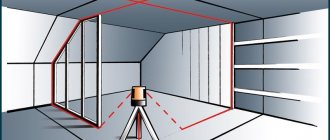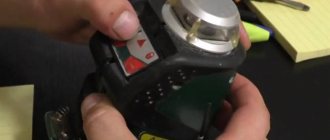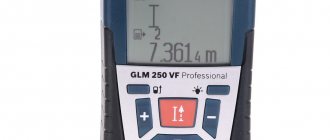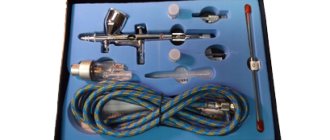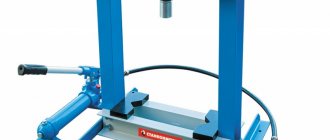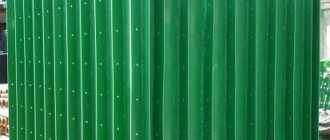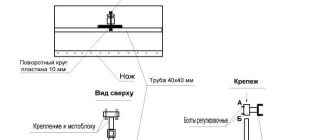- How to choose a self-leveling laser level
- Laser level: design and operation features
- Emitters
- Optics
- Maintaining balance
- Control and power supply
- Types of laser levels
- Rotary levels: laser level self-leveling 360 degrees
- How to choose a self-leveling laser level: main characteristics of the devices
- Video: how to choose a self-leveling laser level
How to choose a self-leveling laser level
Even the simplest repair will not be complete without the use of a building level. Previously, in the old fashioned way, all kinds of hand-made plumb lines, stretched threads, and water bottles were used. Now the need for such applied creativity has disappeared completely, because laser levels have appeared on the construction market. These are unique devices that allow you to carry out any construction work with high precision. How to choose a self-leveling laser level? What characteristics should you pay attention to first? We need to figure it out.
A device for determining height differences: how to use a level (read more)
Using a self-leveling laser level.
We make a laser level with our own hands from scrap materials
A laser level or level is a convenient and useful tool, the need for its use arises not only when carrying out repair work. However, this tool has a fairly high cost, which makes it inaccessible to some of the craftsmen.
If you can’t purchase one, you can make a laser level with your own hands. Moreover, the manufacturing procedure is not particularly difficult, so any home craftsman can handle it.
Principle of operation
The principle of operation of a laser level is that a projection is created on the required object or group of objects. The role of the laser beam is played by an LED emitting a luminous flux. Special prisms and lenses make the beam bright and directional. Such equipment is simply irreplaceable when carrying out finishing and construction work both indoors and outdoors.
A homemade laser level is an excellent alternative to an expensive laser level. Manufacturers supply mainly 2 types of levels: static and rotary.
The main difference between them is that the rotary one is equipped with an electric motor, through which the laser rotates, and a focusing lens, while the static one consists of a prism onto which the rays are projected.
The diagram above shows how the level works. The operating principle of the device is actually not complicated, but accuracy is very important. The high cost of such instruments is due to the high cost of components that are used for the production of levels. If you need a laser level to use at home, you can make it yourself.
How to make a laser level with your own hands
The easiest way to make a level is to use a laser pointer. The costs of manufacturing such a device will be insignificant, since you only need to buy a laser pointer and make all the other parts yourself.
When starting to make a level from a pointer, it is necessary, first of all, to ensure reliable fastening of the element, which at the same time could rotate around its axis. To make a homemade device, you will need a list of the following materials, tools and parts:
- laser pointer;
- a wooden beam measuring 25x25 cm and about 0.5 m long;
- drill or screwdriver with drill function;
- cord;
- support.
Let's start making a laser level from a pointer:
- It is necessary to drill two holes in the block on both sides parallel to each other. One hole is intended for securing the pointer, and the second for the cord.
- After fixing the laser pointer, you need to fix the cord. The cord is intended to hang the resulting device. The hole for the cord must be of sufficient diameter so that the rope passes through it freely.
- After the cord is pulled through the hole, it should be tied to the block and tightened tightly.
- As a supporting surface, you can use any stick (sharpening one side into a point, you can stick it into the ground), a shovel, a tripod, etc.
An important rule when using a homemade level is reliable fixation of the support. After manufacturing such a device, it should be checked for quality of operation. It is recommended to carry out the check in the evening so that the point can be clearly seen.
Initially, you should hang the instrument by a cord in the center of the room. After this, the level should be turned in the desired direction, and then a mark should be made on the wall.
Such a self-leveling level can be directed in any direction where marks are needed, and then begin work.
The second option for manufacturing a laser level involves using foam plastic and a container of water. Initially, you need to take a small container, as well as a piece of plasticine or tape. You will also need a laser pointer and a piece of foam.
The manufacturing process is as follows:
- The container should be filled to the brim with water.
- Attach the pointer to a piece of foam.
- Place a container of water at the height required for marking.
- The foam along with the pointer should be placed in water.
- After this, you should turn on the pointer.
- When the location of the foam relative to the central axis changes, points are marked. All points will be located directly on the same level.
It is quite difficult to call such a design ideal, but, nevertheless, this level will have a high degree of marking clarity.
Testing a homemade laser level
Now you can resort to testing your homemade device. To do this, you will need to secure the product with a pointed stick. Use a bubble level to level the surface horizontally.
After turning on the laser pointer, it should be aimed at the surface. After projecting the first point, you need to make a mark. By rotating the homemade device, marks should be made. All the resulting points are connected using a metal profile and a pencil.
Pros and cons of homemade levels
Once the laser level is ready with your own hands, you should not expect it to perform any complex tasks. This unit is intended for one-time work, so if your type of activity is related to construction, then it is better to purchase a professional tool. The advantages of a homemade device include:
- obtaining a sufficiently long beam length;
- speed of production;
- no need for financial costs;
- increasing the speed of marking work.
The disadvantage is the fact that this is a homemade tool, so you shouldn’t expect high precision and complex work from it. With a little ingenuity, you can make a level with your own hands, without resorting to purchasing expensive factory models.
Source: https://InstrumentyvDom.ru/izmeritelnyj/lazernyj-uroven-svoimi-rukami
Laser level: design and operation features
In order to understand how to choose a self-leveling laser level, you need to understand its structure and operating principle. A standard laser device consists of several systems working together.
This includes:
- emitters;
- focus adjustment system;
- power unit;
- mechanism for leveling and maintaining level;
- Control block.
Laser level device.
Emitters
Laser level light sources are quite powerful LEDs. They generate monochromatic light. Typically, in professional and amateur devices, the rays are red or green, which are visible quite clearly at a distance of more than 40 meters. Installed LEDs do not heat up, use a minimum of electrical energy and do not shine worse over time.
On a note! The green beam is brighter and is better visible when working during the day, especially at long distances without the use of a special receiver.
Red rays of LEDs.
Optics
Each laser level is equipped with a special lens system capable of focusing the resulting beam at one point. High-quality optics guarantee high precision during operation of the device and clear visibility. Some devices are equipped with special prisms that can scatter the beam and turn it into lines. Such equipment is more convenient to use.
Using a laser level when laying tiles.
The difference between a laser level and a level
A level and a laser type level are similar devices in functioning, although they have some differences. The level is distinguished by higher accuracy and luminous range. It has a lower measurement error and a larger number of points in the projection. The level's glow can be from 40 m without an additional amplifier. For laser models this figure reaches 25 m.
The laser type is used for short-term work. It runs on AA batteries. The level is equipped with batteries and can operate continuously.
Maintaining balance
Such mechanisms use the pendulum rule. If the equipment is aligned strictly horizontally, the built-in plumb line is motionless. With a slight deviation, the pendulum head deviates and, when interacting with a magnetic field, generates a current, under the influence of which the system corrects the position of the level. The most accurate systems are capable of responding to deviations of tenths or hundredths of a degree per 1 m. At 10 m, the deviation cannot exceed 1 mm. Professional devices with gyroscopes and servo drives react much faster to deviations and provide maximum accuracy.
Possible directions of laser beams.
Operating principle and main characteristics of laser levels (levels)
So, having discussed the advantages of using a laser level, let’s take a closer look at this device.
Video: How the device works
How does he work?
The light beam emitted by the LED, thanks to an optical system consisting of lenses specially made for this purpose, comes out in the form of a thin luminous flux that is focused at one point. Thanks to this device, a beam of light can be clearly visible at a very decent distance, up to several tens of meters. Some models of laser levels can be equipped with prisms, thanks to which the light flux turns into a line that is clearly visible on the wall, ceiling or other plane.
By examining the position of the rays, you can understand the principle of operation of the level.
Laser devices have their advantages, since they have a built-in self-leveling function (pendulum or electronic), which allows you to achieve excellent results with a deviation of no more than 0.3 – 0.5°. There are models that need to be manually adjusted, for which they have a bubble level built into them.
Advantages of using a laser device
- The measurements are carried out with very high accuracy - the error at a distance of 1 m is measured in tenths of a millimeter.
- The dot or line is clearly visible. You don’t have to draw a mark on the wall, but get to work right away.
- No lengthy preparation is required to perform measurements. You can start working immediately by removing the device from the case.
- No special skills are required to operate simple instruments.
- All measurements can be performed alone.
What does a laser level consist of?
When determining which laser level is best, several interconnected systems should be highlighted.
Light emitter
The brightness is provided by powerful LEDs. The choice was made on this light source due to its low energy consumption. In addition, the efficiency level of LEDs is very high, which means that they hardly heat up.
If a powerful emitter is installed, the rays will be clearly visible even at a great distance
Under the influence of an electric field, light of the desired wavelength (monochromatic) is generated. Mostly it is red, less often green. The color of the glow is not important, but it is green and red that are best visible even at a distance of up to 40 m.
Another distinctive feature of using lighting sources is that they do not contain a filament, so even if the device is dropped, the LED is not damaged. In addition, the radiation intensity remains almost unchanged over time.
Optical systems
The LED itself produces scattered light, so to focus it, an optical system is assembled from a system of lenses, thanks to which the output is a laser beam, the thickness of which practically does not change even at a distance of 100 m.
Cheaper devices use low-quality optics, which can significantly affect the accuracy of the measurements taken.
In addition to the optical system, the levels are equipped with prisms that scatter the beam at an angle, thanks to which we can see it on the surface in the form of a bright line. In some devices, the head, rotating around its axis, “draws” a line along all the walls. Thanks to a very high rotation speed of up to 600 rpm. the line appears continuous.
Device position adjustment mechanism
In the design of most models, to maintain balance, the principle of a pendulum is used, the operation of which is ensured by a freely fixed plumb line. While the device is on a flat surface, there is no need for adjustment, but in the event of even a slight deviation, the head of the plumb line, interacting with the magnetic field surrounding it, begins to generate a pulse, the power of which increases with increasing angle of inclination of the device. The control system receives the impulse and adjusts the position of the emitter with optics, resulting in the beam being installed in a horizontal position.
The speed and response limit depend not only on which company manufactured the device, but also on its accuracy class. It is quite clear that you can’t hope to get ultra-accurate results from cheap models, but, as a rule, this is not required for the household level.
As for professional monitoring systems, they are triggered when the beam deviates by tenths of a degree at a distance from the device of 1 m, and at a distance of 10 m the deviation does not exceed 1.5 mm. Automation is activated when the device is tilted from 3 to 50°. In the event that the device is outside the zone of maximum permissible values, the warning system is triggered - a sound or light alarm. In this case, human intervention will be required to adjust the position of the device and its additional adjustment.
In more expensive models, the system is controlled by a servo drive, the signal to which comes from a gyroscope. This technique is not only more accurate, but also more complex, so an untrained person will not be able to work with it. The response speed is a fraction of a second.
Control
The laser level control panel is simple and intuitive
Some types of professional devices are difficult to use, but most devices, which have only a few buttons on the control panel, can be controlled by an untrained person. If the device has a rangefinder function, then in addition to the buttons on the body there will also be a display on which accurate distance data will be displayed.
Many devices have a button that turns off automatic horizon adjustment. This function is provided in case the device is used when constructing inclined lines. In some models, you do not need to turn off leveling to perform this work.
Nutrition
Professional and some other models of high-quality devices are powered by batteries, the charge of which will last for 8–10 hours with active use of the device. Charging is done from a 220 volt network. Cheaper models intended for home use use batteries for power.
Target and laser receiver
The target is used when marking a suspended ceiling, for leveling the floor, when installing sewers, storm drains and for other similar operations. Having placed the target in the desired location, the laser level beam is directed at it. Using the target markings, it will not be difficult to set the desired slope! Using a laser receiver (for example, Bosch LR 1), you can increase the range of the laser level up to 200 m. You can work with it both indoors and outdoors.
Kinds
Using 2 signs, you can divide the levels into groups:
- Measurement accuracy.
- Principle of operation.
As for the degree of measurement accuracy, we distinguish 3 types of devices:
- Axis builders or as they are also called “point lasers”.
- Static builders.
- Rotational builders.
To figure out how to choose a level, let’s look at the description of each of them in more detail.
Axis builders (point lasers)
Laser point level will provide projection of clearly visible points
These devices belong to the class of static builders, because their design does not include a rotating emitter. In addition, the laser is not displayed as a line - only a dot is projected onto the surface to indicate the direction. In this case, this is not a drawback, because that is exactly what is intended. The device is used in large premises, such as production workshops, offices, or sales areas, because the range of the concentrated beam is slightly higher than that of a scattered beam in the form of a line. One of its advantages is that the unscattered beam is clearly visible even in sunny weather.
It will also be useful to consider the technical characteristics and general performance of devices of this type:
- small measurement error of 1 – 3 mm at a distance of 20 m;
- equipped with a self-leveling mechanism with slope compensation up to 5°;
- if the capacity of the compensator is exceeded, the warning mechanism is triggered;
- It is possible to disable the self-leveling function;
- can be mounted on various surfaces;
- Additionally, targets and signal receivers can be used.
Devices from different manufacturers may differ slightly in the number of beams. Most often there are 3 of them - up, down and forward, but if necessary, you can purchase an axis builder that has 5 rays that are directed forward, left, right, down and up. Whatever the functionality and technical equipment of the device, all projected points are strictly perpendicular to each other. Point lasers are used:
- for transferring vertical projections between floors;
- when determining the direction of installation of frames, formwork and partitions;
- during the construction of walls;
- when transferring markings from the floor to the ceiling.
Devices with upward and downward beams are often called laser plummets, which is not entirely accurate, since this is only one of the functions available. For example, by placing the device on the floor, we will only get the zenith, but by raising the device on a tripod we will also get the nadir, which will help transfer the marking to the ceiling. There are devices with a forward and raised emitter, so you don’t need to use a special tripod to work with it.
Among the simpler models, we can note laser levels, in which the rail with a bubble is supplemented with laser emitters. This device allows you to visually lengthen the measurement line. In the same category are point angle builders. You can also purchase combined devices, such as “crossliner x point plotter”. Which can be very convenient when performing certain jobs.
Static line and plane builders
The laser plane builder is more convenient to work with, as it can work in several planes
Devices of this type are usually used for marking indoors when performing finishing and repair work. Sometimes they are used for marking facades or when leveling small areas.
Static line builders, unlike rotational line builders, produce statically directed lines. Since there are no rotating parts in the device, the lines are obtained by splitting the laser beam using special optical prisms. Because of this transformation, the beam is visible at a short distance - 20, less often 40 m.
If there is a receiver (not all devices have the ability to use it), the marking radius can be expanded to 100 m. Due to the fact that devices have different characteristics, you need to learn about the functional features of the device before purchasing it.
There are so-called “multi-prism” devices, which can contain several prisms, diodes, and beams. Previously, there were models that gave one line. Modern simple devices show a “laser cross” (2 lines intersect at right angles). Advanced static plotters are capable of displaying multiple lines and crosses. In addition, they have a plumb-line function, emitting a point laser upward or downward.
When choosing a device, you need to pay attention to the beam scanning angle. An indicator within 120° would be acceptable. In more advanced versions of static builders, this figure can reach 160° and even more. It’s good if the device has a function for obtaining additional line intersections (crosses). This will allow you to connect multiple horizontal and vertical lines into a full plane, spanning 360°.
To operate in economical mode, the device can turn off some lines (except for the downward-directed vertical beam) that are unnecessary for performing a specific job.
On the positive side, it should be noted that almost all modern static builders are equipped with a self-leveling system (pendulum or electronic). By placing the device on a more or less flat surface and waiting just a few seconds until it levels itself, you can be sure that it is aligned parallel to the horizon line. Even if you accidentally snag the device, you don’t have to worry, since the alignment process will happen again automatically.
Rotational plane builders
Rotary plane builders have one or 2 rotating heads, the rotation speed of which can be adjusted
This type of device is used to determine the direction of marking and to determine the height difference between the desired points. Unlike a line builder, a laser level does not scatter the beam, but marks a plane due to the head rotating around its axis, which made it possible to achieve a decent operating range of the device. This feature allows you to successfully use the device not only in large areas flooded with sunlight, but also indoors. In addition, you can change the rotation speed of the working head in the range from 10 to 600 rpm. This option not only helps you select the desired mode, but also saves battery power.
Rotary plane builders are very expensive, so their use is considered most appropriate when working with large objects and when constructing load-bearing structures. This is due to the fact that the range of the laser is 50–70 m. If you use a receiver that catches the beam in an open area and signals this, the range of the device increases to 300–400 m.
There are useful developments that make using the device more convenient. There are rotational builders that can:
- can be mounted on a tripod in different ways and automatically leveled;
- create inclined planes;
- work with compensators completely disabled, or one of the axes can be controlled by the device, while the other must be set manually;
- be equipped with a remote control with the same buttons as on the device body.
The design of rotary instruments has an “out-of-level” function, which will not allow making incorrect markings in case of a serious deviation from the norm exceeding 5–6°. The self-leveling device must be turned off when storing or transporting.
Control and power supply
The laser level is battery powered. For these purposes, manufacturers mainly use nickel-cadmium options, which can be recharged from the mains without any problems. A high-quality battery ensures uninterrupted operation of the device for 7-10 hours during continuous operation. Control on all models is very simple and is carried out using several buttons.
Using a laser level in construction.
Rating of inexpensive laser levels: the most popular models for apartment renovation
BOSCH Universal Level 2 Set
- Sweep angles: 120°
- Automatic leveling
- Self-leveling angle 4°
- Beam color: red
- Batteries: AA batteries
- Continuous operation time 5 hours
For those who are buying a level for the first time, we advise you to immediately purchase a kit with a tripod. In any case, you will need a tripod. BOSCH UniversalLevel 2 has pretty good characteristics, so we are pleased to include it in the top laser levels chosen by customers in 2021.
The device projects horizontal and vertical lines with a scanning angle of 120° - this will be enough for housework. There is a self-leveling system, and it can be turned off (for example, to draw a line at an angle). In addition to laser lines, the level can also display plumb points.
ADA instruments CUBE MINI Basic Edition
- Change range: up to 20 m
- Automatic leveling
- Self-leveling angle 3°
- Beam color: red
- Batteries: AA batteries
- Continuous operation time 20 hours
Refers to a linear type of levels that draw a crosshair on the surface, which can be used to navigate when placing objects. The device has many modifications, but they all have a very remarkable form factor: a small rubberized cube that can be placed against any surface.
The device is equipped with a class “2” laser, so you don’t have to worry about accidentally getting the beam into your eyes. When the desired projection (vertical or horizontal) is established, the device notifies with light and sound indication. This cube can be mounted on a tripod if necessary (must be purchased separately). The level operates on two AA batteries.
Bort BLN-15
- Measuring range: up to 15 m
- Automatic leveling
- Self-leveling angle 3
- Disable auto-leveling
- Beam color: red
- Batteries: AA batteries
This device also belongs to linear levels, but at the same time has a rotating design, which is why it resembles rotary models. It is already mounted on legs, so you can do without a tripod. The power reserve is enough for 15 m..
The device is additionally equipped with a bubble level for more accurate laser adjustments. Here the error is only 0.2 mm/m, which, given its low cost, is a very good indicator. The level can operate either from two AA batteries or from the mains. However, to operate from a wall outlet, you will have to purchase a separate cable and plug. This laser level (level) is suitable for those who do not want to pay a lot of money, but want to get an excellent tool for homework.
INSTRUMAX ELEMENT 2D
- Automatic leveling
- Self-leveling angle 4°
- Accuracy ~0.2 mm/m
- Beam color: red
- Batteries: AA batteries
This line level has a plug-in receiver that increases the beam range. Without the receiver it is 10 m, and with it - as much as 50 m, which makes it suitable for country house construction. The level can create markings both vertically and horizontally, as well as diagonally. It has a convenient cubic form factor and a lightweight plastic body.
A class “2” laser emitter is installed here, so the beam entering the eye will not affect a person’s vision. According to customer reviews, the level provides ideal beam accuracy, tested in practice with plumb lines and a hydraulic level. Overall, this is a great interior device for the money.
BOSCH GLL 2-10 Professional
- Automatic leveling
- Self-leveling angle 4°
- Disable alignment
- Beam color: red
- Batteries: AA
- Auto shutdown
- Continuous operation time - 9 hours.
The BOSCH company produces many models of laser levels, but this one is the most popular. The level is also linear. It has many automatic functions: it can self-level, automatically turn off after self-leveling, and has a light indication. The model is capable of operating at temperatures from -10 to 50 °C, so it is suitable for outdoor work. True, it has a short measurement range, only 10 m. If desired, you can purchase an additional receiver that will increase the range of the beam.
In the cross-line mode, the device can work for up to 9 hours, and in linear mode (horizontal or vertical only) for up to 17 hours. But from personal experience, we can say that it is extremely rare to use a laser level for more than 1 hour a day, let alone 9. If there is no manipulation of the level for a long time, it will turn off to save battery power.
ELITECH LN 360/1
- Accuracy 0.2 mm/m
- Automatic leveling
- Self-leveling angle 4°
- Disable alignment
- Beam color: red
- Batteries: AA batteries
- Continuous operation time - 12 hours.
Let's not ignore the model from the domestic manufacturer. According to experts and ordinary users, it is no worse than its foreign counterparts. Thus, the connected receiver provides a beam range of up to 80 meters, and even without it the level “hits” 30 m. The marking is built horizontally, vertically and diagonally, and is leveled automatically or manually. By the way, the level is rotary, and a line can be drawn around the entire room. In short, ours have collected all the best practices in this area.
An undoubted advantage is the presence of a bag and holder (mount), which come with the device (in most models, all this will have to be purchased separately). This is the best option for placing beacons under screeds, doors and windows.
Condtrol UniX 360 Green Pro
- Horizontal angle 360°
- Automatic leveling
- Self-leveling angle 4°
- Disable alignment
- Beam Color: Green
- Batteries: AA batteries
- Continuous operation time - 3 hours.
Finally, let's complete our selection with a rotation level with a green beam color. It has the highest measurement range in our selection: 100 meters with a receiver, 50 without it. So this device is suitable for both large rooms and outdoor construction work (for example, laying the foundation of a house). The only problem is the short battery life: in order to generate a beam of such power, you have to spend more energy.
It is capable of projecting two vertical lines or two crosshairs at the same time. A nice feature is the included bag, as well as a power cable for connecting the level to an outlet. But remember one thing: the level can only be used in positive weather of at least 5 °C. At a lower temperature, the device will produce a high error. All laser levels in the best rating are good in their own way and suitable for different tasks. The choice of what to buy is yours.
Types of laser levels
To decide how to choose a self-leveling laser level, you need to know about all the existing varieties. There are several types of such measuring instruments.
Depending on the measurement accuracy, additional functions can be distinguished:
- laser rangefinders;
- static simple line builders;
- rotational plane builders.
Using a laser level for flooring.
A laser rangefinder allows you to accurately measure the distance to an object, calculating the time it takes the beam to travel to the desired point. Professional equipment is often equipped with such a device.
Static builders are devices of a higher level. They allow you to get intersecting horizontal and vertical at an angle of 90º. Can project 2-8 lines at one time. Such models already use a prism optical system.
Installing door frames using a level.
What is a laser level
A laser level is an optical, electromechanical instrument that projects points, lines and planes onto a surface with a clear horizontal, vertical or specified oblique orientation. Designed for a wide variety of external and internal construction work on measuring and marking surfaces with an accuracy of a fraction of a millimeter. Its use greatly simplifies all marking activities and reduces the time spent on them (up to 60%). Household and professional laser levels are divided into four categories.
- Point – display only points in different planes (from 2 to 5).
- Linear – project rays into a line, forming crosshairs and planes.
- Combined – projection of points and lines.
- Rotary – have a large operating range due to their operating principle, which is different from linear ones.
For interior work, linear laser levels or combined laser levels are used, with the projection of beams and points - this is the optimal combination of functionality and cost.
The simplest point level will not be enough for all operations, and a rotary level is redundant.
Egor ManinHead of Professional Measuring Equipment BOSCH
Using combined laser levels that project lines and points, you can perform the entire range of standard finishing work. The combination of the precision of laser lines and the practicality of plumb points gives the versatility of one device for horizontal alignment and checking the correct installation of window and door units or the evenness of walls, as well as transferring points from the floor to the ceiling. And the self-leveling function in these construction lasers makes working with the tool as easy as possible, ensuring accurate results.
Rotary levels: laser level self-leveling 360 degrees
Rotary builders are the most powerful, high-quality and multifunctional devices. They are equipped with a head capable of rotating and creating an image of a luminous plane horizontally and vertically. Such models are often equipped with remote controls.
Due to the rotation of the light beam, the device forms a plane. This laser level makes it easy to check any surfaces and identify flaws. An additional function in it is the ability to create a beam directed strictly to the zenith. Manufacturers claim the beam range is about 50-70 m, but when using a special receiver, this figure can be increased to 300-400 m. The level head can rotate at a speed of 10-600 rpm. The higher the speed, the better and clearer the image.
Rotary laser level.
The 360 degree self-leveling laser level is a fairly powerful and easy-to-use device. Its head can rotate in almost any direction, creating both horizontal and vertical planes. Its self-leveling indicator is small, up to 4 degrees. There are samples with self-leveling up to 60º, but they are very expensive and their purchase may simply be unprofitable.
Spit LR 150 rotary laser level device.
Level design
This device is equipped with a durable plastic housing that protects it from dust, dirt and moisture. For normal operation of the device, it requires a special tripod or a flat surface.
Currently, there are two types of laser levels:
Plasma models. They have built-in special prisms through which diode light passes. The number of lines depends on the number of these same prisms. For example, a level with two prisms will produce a vertical and horizontal line. Devices in this group are most often used in everyday life because they are characterized by a short range of the light beam.- Rotary levels. This equipment is already considered professional and is used in large-scale construction. The long range of the beams is due to the operation of a rotating diode that projects the light.
Rotary levels, as a rule, have more functionality than plasma levels. These devices allow you to designate circular sectors and level doorways. However, a wide selection of functions, of course, affects the price of the device.
There is another type of building levels - point levels. But it is not very convenient to use.
How to choose a self-leveling laser level: main characteristics of the devices
There are many indicators on which the accurate and uninterrupted operation of a laser level depends. We list the main ones:
- error;
- operating range;
- type of laser;
- power class;
- battery capacity;
- self-leveling function;
- protection;
- equipment.
Using a self-leveling level for arranging the ceiling.
Error is one of the important characteristics of any level. The result of work directly depends on this indicator. Its values should not exceed 1-3 mm per 10 m. Professional devices have an error of 0.5-1 mm. When working indoors, an error of 3 mm is almost unnoticeable; such equipment is perfect for use at home.
Complete set of laser self-leveling level LEICA Lino L2.
Medium construction levels are equipped with class 1 or 2 lasers. These are low- and medium-power light sources, but even they can have a detrimental effect on vision. Class 3 laser is used in professional devices.
Battery capacity is also an important indicator. Professional devices work without interruption for about 30 hours. For less powerful equipment this figure is 10-12 hours. For home use, batteries with a medium capacity but with a high charging speed are suitable.
Diagonal laying of tiles using a laser level.
On a note! The self-leveling function in the device must be able to be disabled. This is convenient if the device needs to be placed at a certain angle.
Since 360 degree self-leveling laser levels are often used in rather harsh conditions, their internal parts must be reliably protected. For high-quality models, special sealed and shockproof housings are used. For greater convenience, many samples are equipped with safety glasses, a case for equipment, and a tripod. The kit should also include a charger if the device is battery operated.
A laser rangefinder is capable of calculating the distance to an object.
Knowing all the intricacies of the design and operation of laser construction levels, you can choose a good option for use at home. Powerful and high-precision models can be left to the professionals.
Selecting a laser level and important parameters
When choosing laser levels for indoor or outdoor work, you need to pay attention to its technical indicators. Such information includes:
- The temperature at which the device is able to function normally. If you plan to use it outdoors, then the temperature value must correspond to the limits from -10 to +50 degrees
- Plane projection range. To obtain markings on walls and ceilings indoors, range does not matter, which cannot be said about working outdoors. On average, the range varies from 50 to 300 meters
- Error. Any level has an error; therefore, the higher quality the product, the less error the final result will have. The smaller the error value indicated in the technical specifications, the higher its accuracy
- Number of projections. The more projections a device can build, the more efficient and practical it is. The optimal value is the ability to construct a vertical and horizontal plane
- Method of mounting the device on a tripod. Typically, products are sold together with tripods, but if necessary, they can be purchased separately. In this case, it is important to take into account one such parameter as the diameter of the thread for fixation. Even if you didn’t guess the thread diameter, you can always use an adapter
- Nutrition. It is best to give preference to levels that have built-in batteries. At the same time, you will not need to constantly spend money on buying disposable batteries, which are discharged even if the product is not used. Even if you settled on a point or linear option, which often have space for installing AA batteries, it is recommended to buy special batteries for recharging them
- Degree of protection. The possibility of operation in conditions of high humidity, dust, etc. depends on this parameter. If this is an outdoor device, then it must have an IP mark.
- Availability of additional functions. A good level not only has the ability to project planes, but also a built-in level gauge, through which the body of the level is leveled. Additionally, the devices are equipped with automatic devices for adjusting the angle of location, a self-shutdown function, and a range finder. All these options significantly affect the final cost of the device.
Which laser level to choose for your home is up to everyone to decide for themselves. If finances allow, you can purchase a rotary device, but whether it is worth spending that kind of money on a tool that is used once every few years is up to you to decide. Knowing their main parameters, differences and technical information, you can make the appropriate choice in the right direction.
